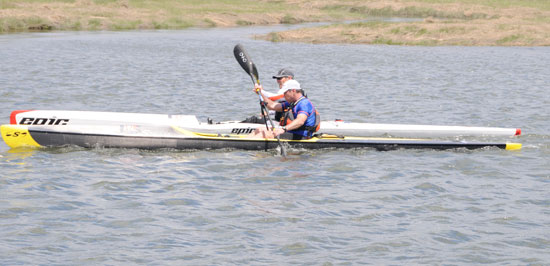 Disclaimer
Disclaimer
Unlike my other reviews where I had no formal industry ties; this review is unique in that I am the Northeast Sales Representative for Stellar and based on my experience of paddling and reviewing surfskis have provided Stellar with feedback both during the prototype testing of the larger Stellar SE as well as the development of the newly released SESbased on my experience reviewing surfskis. Like all my other skis that I have reviewed; I did purchased all the skis for this review. I point this out because many reviews are done on loaner/borrowed/sponsored skis and often only paddled a few times before the review is written.
Feedback from many readers has been that my surfski comparison chart, reviews, and Surfski Basics DVD have been helpful to many novice, intermediate, and advanced intermediate paddlers like myself. I have gotten feedback from all over the world reporting that this information has been helpful to them in purchasing a ski. If nothing else the reviews are a point of reference to be able to ask appropriate questions. Ultimately it is up to the paddler to gather all the information that is available and make an informed decision on the purchase of a ski. I am very pleased to have been able to share my experience with paddlers around the world as the sport continues to grow.
Introduction
While I paddled the larger SE prototype a few months ago, I had been anxiously awaiting the SES model, the model specifically designed for small to mid-size paddlers like myself. So like most of us reading this, I asked myself some of the familiar questions. Will I like the fit? How fast is it? How stable is it? How is the construction? Having come off my best racing season last year, I certainly did not want to be purchasing and racing boats that would compromise my having another good racing season.
For this review I included several pictures of the most common waters I paddle in to give you a better sense of the conditions I review the boats in. Narragansett Bay, Rhode Island Sound, Sakonnet River are some of the best places to paddle along the Eastern Sea Board due to its varied conditions and access to these waters. Newport, Rhode Island is one of the Sailing Centers of the World for the same reasons. Maybe in the future, an East Coast Surfski Championships could be held here. Good enough for the America’s Cup, good enough for an East Coast Surfski Championship!
Speed
How fast is it? The $2,400 to $4,400 question. I received the boats on the Thursday before the Essex River Race, a six mile tidal river race that kicks off the New England racing circuit, not leaving much time to get the ski dialed in the way I typically would with a new boat. So that morning of the Essex Race, I put the four inch flat water rudder on and hoped for the best. The conditions were one foot beam chop in winds ranging from 15 to 30 mph. Tim, my other training partner who owns my original V12 paddled it with his custom flat water rudder. We raced the entire race together finishing in a photo finish. My burning question had been answered: does it have the top end speed of other high performance skis on flat water? Absolutely!
Flat water is one thing, but what kind of speed does it have in ocean conditions? Fast forward a few weeks to the Sakonnet River race. This was a 12 mile race, with some of the familiar faces on New England racing circuit, albeit missing a few since the violent thunderstorms kept a few away. The SES ultra answered the call again; this time in mixed conditions upwind and downwind conditions. I was able to win the race by almost a minute in 1:48:52. I did have a chance to paddle the SES 70 miles between the Essex and the Sakonnet getting the new ski dialed in.
On my 3.18 mile time trial course I use to compare all my skis, the SES in the Advantage Layup (31 pounds), I had the 3rd and 5th fastest times ever. So even this modestly heavier layup has excellent speed. Another indicator of its speed is how fast I am in comparison with my calibrated training partner of many years. For instance last year I calculated our total race times in the 10 races we did to get the overall differential in our times. We were within a minute total of each other over the 10 races. That is normalization! Over the years I have raced a different boat every year, so Tim represents my baseline to compare how I am doing since he remains the constant having raced predominently a V10L ultra and a V12 (last year). In our training sessions, my times and heart rates have mirrored Tim’s since I have been paddling the SES. Tim and I are the same age as well.
I also have paddled the SES Ultra, Excel, Advantage layups in mixed conditions including many downwind conditions in 2-4ft seas which is typical in certain areas in Rhode Island Sound, and Narragansett Bay. The Ultra/Excel layup accelerates as well as any other ski I have paddled, while as you might expect, the Advantage layup is slightly slower due to the weight. Upwind the bow rarely slaps, and downwind it rarely gets buried.
Most paddlers I have communicated with over the years want to know if the ski they are paddling will limit their speed/performance compared to other skis if everything was equal. Well we all know it is never equal, but I feel very confident that SES has the top end speed of any ski based on these two races, my time trials, my calibration/normalization with my training partner Tim over 200 miles in varied conditions that I have accrued thus far on the SES in all three layups. Lastly, the speed is very deceiving as others have commented regarding Stellar skis. If you don’t put a clock on it, and go by “feel”, you will be tricked into thinking you are not going as fast as you are. Why is it so fast? Read on.
Stability
The following day after the Essex Race, I took the Advantage (31 pounds) layup out in true New England ocean conditions in 2-4ft seas for 2 hours off Cormorant Rock (Newport, RI) to give it a proper test of stability. While not quite as stable as the more stable 18-19”class of skis, it is not far off in this layup. Secondary stability is extremely high without having to go through the learning curve of “trusting the boat” which can take months.
The initial stability is very good and reassuring without any of the twitchiness associated with most HPS. Under power the SES has no excessive movement that defines so many other skis in this class. The transition from initial stability to secondary is very predictable. The SES also dampens much of the wave action. Every ski has its own personality in this department requiring varying amounts of “time in the bucket” to gain your confidence in anything but flatwater. Many of us give up on some of the “faster high performance” skis because of this learning curve, especially those who don’t have the ability to paddle in ocean conditions multiple times per week. This confirms what most us know by now, “you can go faster on a more stable and predictable platform”.
While the SES is very stable, what is uniquely different about the SES is how it feels going downwind. Most HPS have some wobble going downwind until you adjust to that particular ski in those downwind conditions. Most novice and intermediate paddlers have the most difficultly going downwind due to this feeling of instability. Due to the flared hull beyond the footplate, the SES is extremely stable with little excessive movement; therefore you can paddle with full power sensing this unique stability in the hull. You can visually see how stable it is, as well as feel it. The tracking is comparable to most other skis; however, the Ultra requires extra attention and more input from the rudder due to the lightness of the ski (a trait that you will see with any ski once you get down into the 20 pound range).
Having all three layups of the SES at different weights, I was excited to test each layup regarding stability and speed. My general rule of thumb is that four pounds of weight is the margin that noticeably affects the speed and stability of a ski. While I have owned almost every ski in at least two layups, never have I had three layups. The SES comes in the 21 pound (ultra), 24 pound (excel), and 31 pound (advantage). It comes in a 33 pound version that I have not paddled.
The advantage of an ultra light ski is that the acceleration is instant when trying to catch a bump, get on someone’s wash, or close the gap on a competitor. It also requires much less energy to propel it through the water especially over a long race. The minus is that you give up some degree of stability and in a long race in rough conditions and this can cause boat fatigue for all but the well trained paddler. The SES Ultra is no different.
The SES Ultra is the most stable high performance ski but it requires some extra attention while the Advantage requires nothing but having a good time – just put the power down and enjoy the ride. The Excel, like other skis at this weight (24-25 lbs) is an excellent weight for performance training and racing.
Design and Fit
The SES model was specifically designed from the ground up for the small to mid size paddler (hull, deck and bucket). I can’t help but make the comparison to the sleek design of a breed of dogs called Whippets. Whippets are small framed, leggy, sight hounds that can reach speeds of up to 35-40mph in short burst while chasing prey of rabbits or squirrels. They are the fastest dogs on the planet due to their unique build and running style that is maximized for speed and agility in a small package. We just rescued a Whippet/pointer mix yesterday and she is amazingly sleek and lighting fast. So like the Whippet, the SES model was built to maximized speed and stability for paddlers 140 to 190 pounds. It is only 20 feet, 4inches in length and has one of the narrowest beams at 16.6 inches with a narrow bucket.
Cockpit
The narrowness of the bucket will exclude some paddlers who think of themselves as mid size. I fall into that mid size category at 5ft 9inches and 175lbs. The bucket fits me perfectly with no padding in the hip part of the cockpit. I took a measurement of my hips (widest point) and they are 39 inches. Since fit is such a key factor, I wanted to be clear that if your hips are much larger than this, the bucket maybe too narrow for you. So like all skis you need to try it for comfort before purchasing. I found the bucket to be very comfortable. I have done several 2.5 to 3 hours continuous paddles with no hint of tight hamstrings, leg numbness or tailbone soreness. Fit is highly individualized, so once again, trying a ski before you buy is extremely important. Stellar is planning on widening the cockpit slightly to accommodate more paddlers. As for as length, the SES will accommodate very tall paddlers, albeit, tall with narrow hips.
The height of the hump is very low. So for shorter paddlers like me (29.5 inch inseam) the hump is thankfully a non-issue. Many skis have the hump placed too high for the shorter paddlers so your calves rest too much on the hump negating maximum leg drive. You can place a pad in the bucket to modify this problem; however, this most often increases your instability. The bucket height to foot well height is appropriately designed for maximum leg drive. The ratio falls in between the other models of skis I have reviewed. The Stellar skis have a built in leash attachment that should be standard on all skis for safety reasons.
Remounting the ski was easy due to its shallow bucket and strong secondary stability. You can lay the ski on its side and practically rest it there, while you remount. Although the bucket is shallow, the footwell is fairly deep with high gunwales forward of the hump so the ride is very dry.
Draining the water from the cockpit varies from ski to ski. The SES sitting still has a large volume of water in the footwell. It drains more slowly than many other skis taking approximately 45-60 seconds to clear. Once it is clear, and you are paddling above a 5.2 mph most all of the water is clear. I found at my training and race pace this not be a problem. Once above 5.8 mph the footwell is virtually water free. Stellar however is working to improve this even further.
With the exception of the Red 7, the SES has the only 3 point footplate which means it has the most solid footplate of any ski I have paddled. The footplate has the conventional attachment points on each side of the foot well, but with the added camber locking center rail system that allows you to absolutely push as hard as you can on the footplate with no creaking, scraping, flexing, or bending, (rock solid). Due to the center rail system, the plate does not touch the bottom of the foot well so it is easy to adjust the footplate without forcing the footplate along the bottom of the foot well which can be annoying in many skis. The footplate height is different in the SES model vice the SE model. The footplate on the SE model is oversized for paddlers with extra large feet while the SES model has a standard size footplate. The foot strap while serviceable, can be easily removed which is what I did. I replace this with the Linke foot strap with the addition of my Timbuk2 shoulder strap pad that makes for a wonderful foot strap that I have on all my skis. I could put 3 Garmin’s on these foot straps and it still does not flop into the bucket. This is also very helpful in remounting during larger seas where less rigid footstraps tend to collapse when trying to re-secure your feet.
The Stellar skis use spectra line for rudder lines which has its pros and cons as I have mentioned in other reviews. The “sponginess” in comparison to steel cables can give the sensation of a less connected feeling, yet in the Stellars, overall steering (hull, rudder combination) is comparable to the top skis in this category… My pet peeve of tying the rudder lines while adjusting the rudder pedals for the first few times, still annoys me to no end. True, once you have them tied off like you want, you rarely have to retie them, but never the less, and it takes way too much time in my opinion.
The Stellar skis have a traditional shaped 8 inch elliptical rudder and a nicely shaped flatwater rudder. I used the flatwater rudder in the Essex Race that is notorious for its weeds. Unlike any other rudder, the rudder post on the 8 inch rudder has no forward leading edge so there is no room to collect those aggravating weeds. While you have to use a wrench to remove the nut to switch out the rudders, this is very simple to do with little fuss.
Another unique feature of the Stellar skis is there structural rigidity just forward of the footwell and aft of the cockpit. The area transitioning from the footwell to the deck is a gradual curve to add to the integrity of the ski, unlike the traditional near right angle found in many skis. Also, the rear deck that runs from the back of the seat well to the rudder is raised slightly to add structural integrity to the ski as well.
Quality of construction is very pleasing on these boats. All are vacuum molded. As mentioned earlier, Stellars come in 4 different layups with 4 different price points and weights. The Ultra is made from pre-preg unidirectional carbon fiber to increase stiffness, and decrease weight. This is the stiffest and lightest boat I have every owned. The boats are practically flawless with no rough edges in the transition areas, no soft spots, thin spots, etc. Even the glass layups are extremely stiff. See the Stellar web site for construction details of the different layups.
Summary
The SES offers a near perfect combination of speed and stability for the small to mid size paddler who fits into the narrow bucket, based on typical NorthEast USA ocean conditions
Pros:
- Most stable high performance ski.
- Has top end speed of any surfski.
- Rock solid 3 point footplate that is easy to adjust.
- Built in leash attachment.
- Easy to remount.
- Nicely shaped flatwater rudder
- Four price points in 4 layups at different weights
- Construction is excellent with added structural integrity in key areas
- Comfortable bucket.
- Massachusetts based Sales, Distribution and Warranty Coverage
Cons:
- Narrow bucket may not fit broad range of paddlers (SE model may be better option).
- Could drain better at lower speeds.
- Foot strap needs to be more functional
If you are interested in why I joined the Stellar team, please visit my Stellarsurfski.blogspot.com.~ Wesley
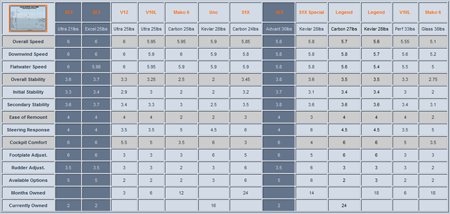 Click to View Larger Version of Surfski Chart
Click to View Larger Version of Surfski Chart
Why Choose Stellar? By Westley Field
(added October 24th, 2010)
I did it! After months of speculation and research I actually made a decision and bought a new ocean ski for this season. The final decision? A Stellar SES. So how and why did I come to this conclusion?
I have been paddling pretty solidly for 2 years now, training several times a week and getting some great advice from Olympic coaches and World Champions. All of this has meant a fairly rapid development in terms of understanding technique and understanding the sport. I have also done some intensive interviews with world class boat makers on features that make designs work.
Finally I have paddled many different craft during my regular travels around the planet.
Currently I paddle an Epic V10L which is a boat designed for shorter paddlers. It is fast but not the most stable. I certainly still struggle in large bumpy conditions in the surf, in particular around headlands during the Ocean Series or Fenn Cup.
As I am an more matured paddler (over 50) I don’t have a lot of time left to be competitive so was fairly keen to find a boat that offered the best combination of speed and stability improvement. My Kayak Coach, Jim Walker, advised me to get a much more stable boat as I would see a marked improvement in speed with the added stability. With that advice I searched the world for the best solution for me.
Taking Jim’s advice, I tried the Think range but found that, whilst the EVO offers great stability (even more than the SES,) the loss of speed would have frustrated me after the speed on the V10L. In retrospect that is probably where I should have started, although with the SES success I would probably look at the Stellar S1R. Think’s UNO has incredible speed but I am a long way from handling that thoroughbred in the surf.
When I was in San Francisco I came across Jude from Huki kayaks. Very impressive. They are an incredibly well built boat and the custom options are amazing. I think their stability and speed is second only to Stellar. I loved paddling the S1 X special under the Golden gate and felt pretty comfortable for a first up run in testing conditions. The problem came in trying to get a Huki to Australia. This proved a little difficult so the search continued.
When I was in Chicago I met Tim Flentye and tried the Epic V12. Loved it and it was certainly the fastest boat I had paddled. I took it out in the excessive bump of Lake Michigan. The huge amount of volume upfront bounced me (a small paddler) around like a cork, whilst I felt fairly stable I am sure the bouncing would make me lose speed. Great boat but maybe not for a smaller paddler.
On getting home I tried the V12 again in flat water and it went like a rocket but alas I just don’t have the weight nor stability to control it in the bump. Next the Fenn elite. Fantastic speed in flat conditions but once again but very unstable in the bump for someone of my ability. I felt that the V12 was slightly more stable in the rough and was leaning towards that.
It was at that point that I read a tweet where my old mate Gavin Clark from Slipstream Surf who had become the NSW agent for Stellar Kayaks. I was particularly keen on trying out a Stellar after having read the fantastic reviews on SurfskiRacing.com and also seeing where Wes Echols placed them on his chart. I asked Gavin if I could give one a try and SES – yes! got one for a week.
First up I I tried it on the flat when I trained with JimSquad. Unbelievable, fantastic speed with an immediate improvement in performance over short to medium distances. I was consistently way ahead of two fellow paddlers that I have previously struggled to keep up with. Nice.
Next the bump. I took the boat our in fairly flat surf conditions on the first round of the Ocean Series, The previous week I had finished 6 mins behind my arch rival over 14kms. This time having missed judged the finish, I was only 30 seconds behind.
The following week out again in the second round of the Ocean Series, this time big bump in the Lion Island challenge. The result, I beat my rival by a good minute. Unbelievable 7 mins gain in three weeks.
The big difference.? The boat is everything Wes Echols described. In my opinion he is not exaggerating anything in his rave reviews. This boat is way more stable than anything else within the same speed range. As a result I could relax in the ski and concentrate on technique. The boat fits me like a glove. The SES is a boat that is built for the smaller paddler not a modified version of a larger boat. I feel very secure, the secondary stability is truly awesome and gives me the freedom and confidence to apply my technique without fear of falling in. The ski really takes off quickly reaching good boat speed. I love the nose which reminds me of the V12 only less volume and therefor less bounce. The front of the cock pit is similar to a Fenn allowing the paddler to get in nice and tight and have a good straight blade entry. The seat in amazingly comfortable with the quality fittings throughout that match Huki. The one time I did come out (and that was very wild conditions) it was an very easy remount. This boat is a quality build all round.
For a person of my ability and size, the Stella SES is a step above everything else I have tried. It is really that good. I feel that it won’t be long before the others manufacturers will have to respond in order to stop Stellar from taking the entire market but for paddlers who are not quite yet able to paddle the most unstable of craft but still want very competitive speed nothing, in my opinion, currently compares with the Stellar SES. The combination of speed and stability that have been captured in the Stella SES if perfect for the experience mid to high range paddler. I look forward to a big improving season. The results will show if I am right or not. ~Westley
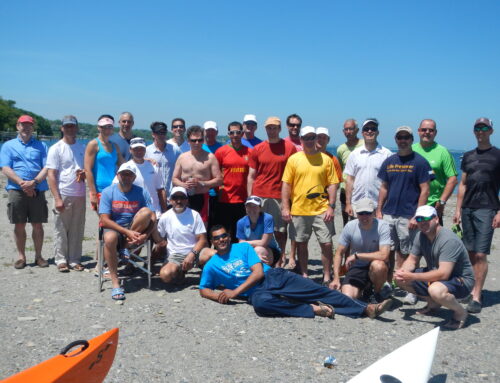
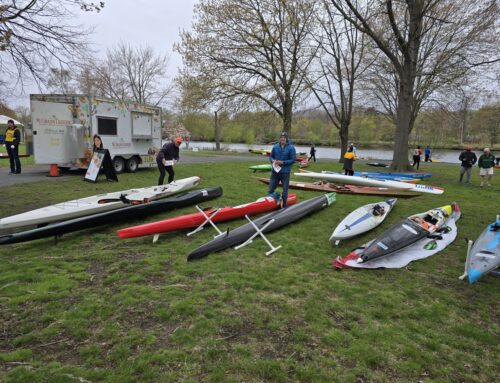
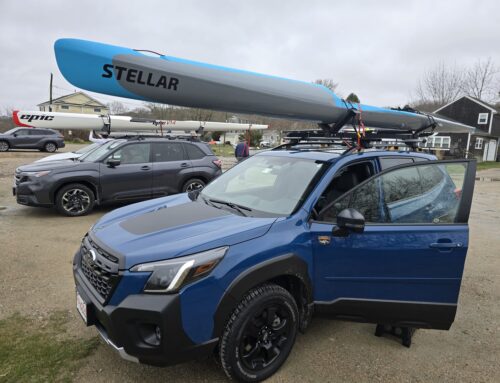
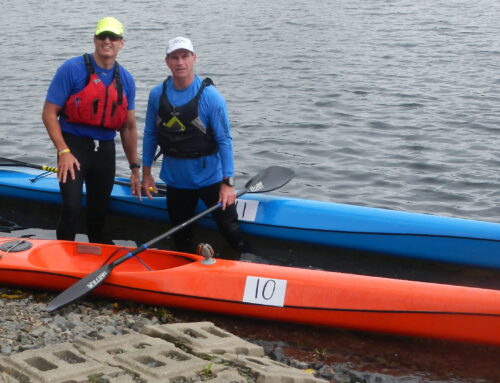
Leave A Comment
You must be logged in to post a comment.